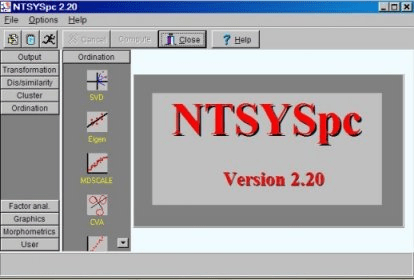You don't have to configure anything, just install TeamPlayer and plug as many mouses as you want, it will manage them. You'll see how more cursors appear on the screen, each one in a different color.
It can be very useful if you are working with a colleague and using the same computer, by that way, you'll be able to use the computer without having to share the mouse.



No password is required. Setauket, NY ntsys pc 2.2 USA. Plot options windows allows you to nntsys the plots specify titles, fonts, ntsys pc 2.2, colors, scales, line widths, colors, margins, and many other aspects of what is plotted. A spreadsheet-like data editor is. Download Center. You can find the documents and files regarding the operating system, packages, desktop utilities and so on for your Synology product to enjoy the latest and versatile features. Download ntsyspc version 2.10 for free. Development Tools downloads - NTSYSpc by Exeter Software and many more programs are available for instant and free download. Clustering Analysis This part is dendrograms’ drawing procedure such as phylogenetic trees. First, you should open NTSYSpc ver. This main part has the three conspicuous stages: 1. Establishing similarity matrix:. Go to “Similarity” tab. Rohlf, “NTSYS-pc Version. 2.02i Numerical Taxonomy and Multivariate Analysis System. Applied Biostatistics Inc., Exeter Software,” Setauket, New York, 1997. Has been cited by the following article: TITLE: Genetic Diversity of Pigeonpea (Cajanus cajan (L.) Millsp.) Cultivars and Its Wild Relatives Using Randomly Amplified Polymorphic.

Ntsys Pc Version 2.2 Free Download
Some of the features include in NTSYSpc are listed below.
Ntsys Pc Version 2.2 Update
- Similarity and dissimilarity: correlation, distance, 34 association coefficients, and 11 genetic distance coefficients.
- Clustering: UPGMA and other hierarchical SAHN methods (allows for ties). Neighbor-joining method (including the new unweighted version). Several types of consensus trees.
- Graph theoretic methods: minimum-length spanning trees. Graphs (unrooted trees) from the neighbor-joining method.
- Ordination: principal components & principal coordinates analysis, correspondence analysis, metric & non-metric multidimensional scaling analysis, singular-value decompositions, projections onto axes and Burnaby's method. Canonical variates analysis. Programs for multiple factor analysis, common principal components analysis, partial least-squares, multiple correlation, and canonical correlations are also included.
- Interactive graphics: phenograms, phylogenetic trees, 2D scatter plots , comparison of dis/similarity matrices, Fourier plots of outlines, Procrustes plots, and 3-D perspective plots.
- Multivariate tests: canonical variates analysis, tests for homogeneity of covariance matrices, tests for number of dimensions, generalized multivariate multiple regression analysis. There are also provisions for bootstrap, jackknife, and simulation experiments.
- Geometric morphometrics: includes specialized modules for Procrustes analysis to superimpose landmark configurations, plotting the results of a Procrustes analysis, Fourier analysis (including 2D and 3D elliptic) of outline shapes, plotting outlines and Fourier coefficients, and computation of 2D and 3D partial warp scores and estimates of the uniform component.
- Other: includes comparison of matrices by cophenetic correlation, Mantel test, 3-way Mantel test, data standardization, and matrix transformations (simple functions, deletion, and now matrix transpose). Matrices can be split or combined.